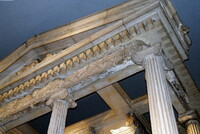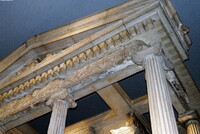| dc.coverage.spatial | Site: British Museum (London, England, United Kingdom) | en_US |
| dc.coverage.temporal | ca. 425-400 BCE (creation) | en_US |
| dc.creator | unknown (Lycian sculptor and architect) | en_US |
| dc.date | -425--400 | en_US |
| dc.date.accessioned | 2013-01-29T20:25:41Z | |
| dc.date.available | 2013-01-29T20:25:41Z | |
| dc.date.issued | -425--400 | en_US |
| dc.identifier | 189695 | en_US |
| dc.identifier.other | archrefid: 1758 | en_US |
| dc.identifier.uri | http://hdl.handle.net/1721.3/98231 | |
| dc.description | Pediment, detail at the corner, looking up; The Nereid Monument takes its name from the Nereids, sea-nymphs (daughters of the sea-god Nereus) whose statues were placed between the columns of this monumental tomb. It was built for Erbinna (Greek Arbinas), ruler of Lycian [Lykian] Xanthos [modern Gunuk], south-west Turkey. Although he was not Greek, Erbinna chose to be buried in a tomb that resembles a Greek temple of the Ionic order. The monument is much influenced by the Ionic temples of the Acropolis of Athens and its lavish decorative sculpture, which can be seen reconstructed and displayed around the walls of Room 17 [of the British Museum], is a mixture of Greek and Lycian style and iconography. The remains of the Nereid Monument were brought back to England between 1842 and 1844 by two expeditions led by Charles Fellows. He is credited with the discovery of the cities of ancient Lykia. Source: British Museum [website]; http://www.britishmuseum.org (accessed 6/14/2009) | en_US |
| dc.format.medium | limestone base; upper courses marble | en_US |
| dc.rights | © Scott Gilchrist, Archivision, Inc. | en_US |
| dc.subject | architectural exteriors | en_US |
| dc.subject | death or burial | en_US |
| dc.subject | figure, female | en_US |
| dc.subject | mythology (Classical) | en_US |
| dc.subject | Funerary architecture | en_US |
| dc.subject | Classical | en_US |
| dc.subject | Lycian | en_US |
| dc.title | Nereid Monument | en_US |
| dc.type | image | en_US |
| dc.rights.access | Licensed for educational and research use by the MIT community only | en_US |
| dc.identifier.vendorcode | 7A3-G-BM-NM-A2 | en_US |
| vra.culturalContext | Lycian | en_US |
| vra.technique | carving (processes) construction (assembling) | en_US |
| vra.worktype | tomb | en_US |
| vra.worktype | frieze (ornamental area) | en_US |
| vra.worktype | sculpture (visual work) | en_US |
| dc.contributor.display | unknown (Lycian sculptor and architect) | en_US |



